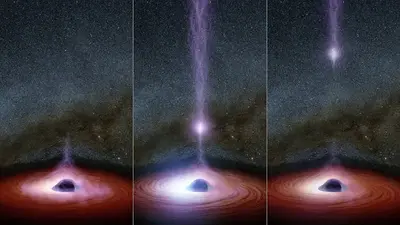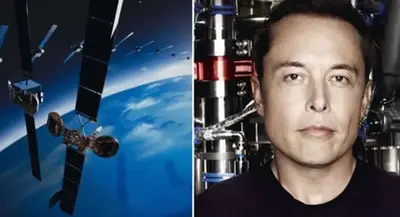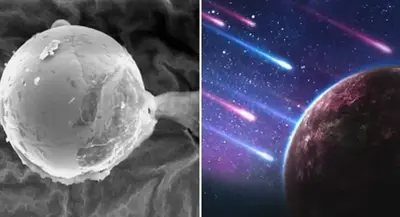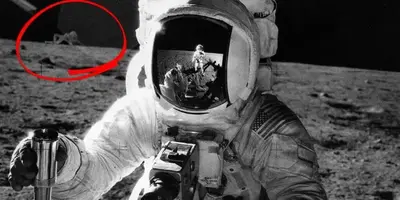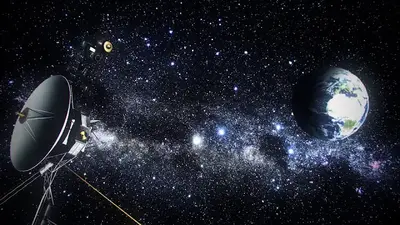Science
780,000 years ago, 2,000-meter-long UFO hovered close to Earth’s orbit before hitting the surface
There is no known record of when the first UFO was sighted on Earth. Now, we have an enormous amount of data to confirm the sightings, but there is much more lost to History. Ancient alien theorists collected several examples that might suggest some medieval UFO sightings. But what is the oldest record of a UFO sighting? About 780,000 years ago (or 790,000-800,000), a strange object entered the solar system with speeds well over 20,000 miles per hour, which was far less than other space objects. It was about 2 kilometers wide, 110 times larger than the Chelyabinsk meteor that hit Russia in 2013.

There are two conceivable outcomes when a huge body falls towards Earth at such enormous speeds: either the object will be accelerated by our planet’s gravity or it will hit the surface. The nature of the second scenario is devastating.
However, studies by NASA showed that the object had placed itself in orbit, perhaps with the ability to slow down. Although some rocky bodies the size of a car or smaller have briefly orbited Earth, our planet is simply too big to make such an impact on objects with diameters greater than a few kilometers. The small, rocky worlds of the inner solar system don’t have the same gravitational effects as Jupiter and Saturn, which are known to deflect fast-moving comets.

The strange visitor experienced a prolonged process of overheating or self-melting that reduced him to glass after an unknown amount of time in orbit. Then, from Antarctica to southern China, bubbles of frozen liquid glass began to fall from the sky.
According to a chemical analysis of the recovered debris, whatever it was, it contained a significant amount of aluminum, iron, calcium oxide, magnesium oxide, potassium oxide and various trace elements, in addition to quartz crystal, which is a essential material for our information processing technologies. A surprising number of them are composites with features that may be important for spacecraft design.
The evidence for this strike is in the form of the tektites. They are fragments of terrestrial material that the impact superheated, melted and then released into the atmosphere. Although some are larger, tektites are typically centimetre-sized pieces of green or black glass. They are known scientifically as “tempered molten ejecta”. They were scattered across a vast region known as Australasia Strewnfield.

No asteroid, comet or natural meteorite known has ever had a silica content greater than 60%. According to several studies, the object could be the first extraterrestrial visitor to our solar system ever discovered because it has isotope traces that suggest an intergalactic origin.
After 200 years of research, the creation and distribution of Australasian tektite still poses a challenge to Science. An interstellar object hypothesis explains any oddities that persisted. When the potential of tektites as a techno-signature is analyzed, it is determined to be strong. No one is quite sure what it was, where it came from or how it got into orbit before exploding after a century of study, making this parent body the first Unidentified Flying Object ever seen.
Some scientists have proposed a huge asteroid collision somewhere in Southeast Asia to explain the australite mystery, while others have argued that it must be the consequence of a piece of the moon exploding and traveling in our direction. While each of these long-debated ideas has strengths, both have failed to explain the available evidence.
The moon hypothesis has the benefit of providing an explanation of how a glass-like substance could fall to Earth from space. Some of the resulting tectitic material could come to us if an asteroid hits the lunar surface and blows up a lot of molten rock. As it became clear that the moon was not composed of a substance that would fit into the australite debris, this theory soon lost steam. The Earth-impact hypothesis offered the convincing argument that the glass contained compounds that might fit in with some mixed shales on Earth.
Could the vast debris field and strange glass formation be explained by a fast-moving object hitting Earth hard enough in the exact right spot? The answer is no, although this model is still widely used. NASA studies make it quite evident that so-called australite buds were generated in space during a long warm-up period before gradually entering the atmosphere. Not only do they have almost no water, but they also have hard vacuum bubbles.
The data suggest that the tektite glass must have been heated by a certain method that eliminated most of the bubbles and left a very homogeneous material. This is perhaps the most difficult aspect of all, as it contradicts the widely established Stokes equation for frictional force in liquids. The energy released during an impact is very strong and fleeting.
What could it be if it weren’t for a piece of the moon breaking off or any other known natural object hitting our planet? Avi Loeb, a Harvard astrophysicist who is a proponent of the extraterrestrial hypothesis, says, “When you’re not ready to find exceptional things, you’ll never discover them.” He perhaps suggests that “to reap the rewards of other technological civilizations, we must search our ‘backyard’ in the solar system for objects that came from outside it. Some of the objects we find may be intelligent, while others burn up in Earth’s atmosphere.”
Has one of these hyper-advanced entities ever visited Earth with our distant ancestors of Homo erectus observing their vast silica network orbiting overhead in the night sky?
A recent study published in ReseachGate entitled “Australasian Tektites as Interstellar Object Debris: Anomalies in Composition, Formation and Distribution” considers the likelihood that the parent body of the Australasian tektites was a natural interstellar object or could have been an artificial megastructure monitor. terrestrial biosphere.
It is also interesting to note that the last full geomagnetic reversal on Earth occurred 780,000 years ago. The complete reversal of the north and south magnetic poles. Could the destruction of the world’s first UFO and the subsequent massive shift in the planet’s energy somehow be connected?
-

 Science1w ago
Science1w agoYou Won’t Want to Miss October’s Rare Comet Sighting. Here’s How and When You Can See It
-

 Science3w ago
Science3w agoA New Spacecraft Could Help Determine if There’s Life on a Moon of Jupiter
-

 Science3w ago
Science3w agoSpace photo of the week: See the gorgeous Rosette Nebula — before it destroys itself
-

 Science3w ago
Science3w agoScience news quiz, October 12, 2024: Do you know your meteor showers from your massive millipedes?
-

 Science3w ago
Science3w agoWe Can Thank Deep-Space Asteroids for Helping Start Life on Earth
-

 Science4w ago
Science4w agoHurricane Milton is tied for the fastest-forming Category 5 hurricane on record. It could become the new normal.
-

 Science4w ago
Science4w agoHere's why storm surge during hurricanes can be so catastrophic
-

 Science4w ago
Science4w ago'Severe' geomagnetic storm to slam Earth Thursday, with auroras possible as far south as California and Alabama


